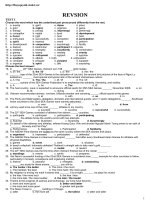CAU Business Communications: Presentations Organizing a Speech
Bạn đang xem bản rút gọn của tài liệu. Xem và tải ngay bản đầy đủ của tài liệu tại đây (38.13 KB, 3 trang )
CAU Business Communications: Presentations
Organizing a Speech
Any form of communication can be organized to become more effective. Let’s look at
the best way to organize a speech. There are 5 main parts to a speech.
1. Opening
○ An opening is a short statement at the start of your speech. It can be a short
statement, question, fact, quotation, joke, story, personal experience, statistic,
news issue and so on. Can you think of anything else you can use as an opening?
○ The main objective of your opening is to set the tone for your speech and create
a good first impression with your audience.
○ It is important because the start and end of your speech is when your (this is
also true of students - they pay the most attention at the start and at the end of
class). A good speaker should take advantage of this. Don't waste your opening
saying things that are irrelevant or unoriginal.
○ Ensure it is relevant to your speech - don't talk about the weather if it has
nothing to do with your speech!
2. Outline
○ An outline is a short and quick list of the things you will be talking about in your
speech - like a list of contents at the start of a book.
○ The objective is to give your audience a quick preview of your speech. This will
help the audience maintain attention and remember the contents of your speech
○ It is important to give your audience a quick preview of your speech. A speech,
unlike written or recorded media, cannot be paused or re-played. If a listener
missed something, it is gone forever and they will not understand the rest of the
speech. Therefore, it is important to give them a preview, to create expectation
of what is to follow (this is also why you give a summary at the end of the
speech).
○ Don’t explain the ideas on your speech, just state them. This part should only
take 20 seconds.
3. Content
○ This is the main part of your speech. This is where you explain your ideas in
detail.
○ Be sure to explain your ideas according to the order you presented them in the
Outline (part 2 of the speech structure) else your audience will become
confused!
○
Each idea in this part should be organized in the structure of an idea
■ Name - this is a short name to help your audience understand and
remember your idea
■ Explanation - logically explain your idea.
■ Evidence - give proof that supports your idea. Logical explanation is great
people it helps people understand, but logic cannot be seen or felt and
therefore feels less "real". People need evidence in order to truly believe
your ideas.
1. Summary
○ This is a repetition of the names of all the ideas and emphasis of the major
○
ideas in your speech. Often it will sound exactly the same as your Outline.
This reminds the audience about the main ideas of your speech and ensures
that they didn’t forget anything. It makes your ideas stronger!
A good summary can save a messy speech, so even if you feel your speech is
going badly, don’t forget to do a summary. Remember, your audience will often
lose their focus in the middle of your speech, but they will always remember the
ending.
2. Closing
○ This is very similar to the opening - anything that can be used in the opening
can be used in the closing.
○ This is the last impression you will leave on your audience - if you end your
speech in a weak, soft and shameful way, the message you are sending your
audience is that you are not proud of your speech. But if you are not proud of
your speech, then your audience will also not be. You must be proud of yourself
before other people are!
○ Also remember that the attention of the audience on your speech at this point is
very high.
○ A simple but effective way to end your speech is to repeat the same thing you
used in the opening of your speech or repeat the topic and your position.
○
So here is a brief view
1. Opening
2. Outline
3. 1st Idea
4. 2nd Idea
5. 3nd Idea
6. Summary
7. Closing
Activity - students in groups prep for a speech and one person takes on each part of the
speech.
Additional Explanations
The objective of speech organization is
a) to make it easier for your audience to understand and follow your speech
b) to use your time in the most efficient way
a) to make it easier to understand and follow your speech...
The speeches you make in a debate or any other kind of persuasive environment is
usually full of complex ideas (just like a speech for a company presentation or during an
interview). Therefore it is important to be able to easily take notes and understand your
speech.
The solution is to plan and present your speech in the most logical manner and in
the way you would like your audience to take down their notes. One thing that helps is to
clearly tell your audience how your speech is organized. This is called presenting your
speech “outline”.
So for example, tell your audience at the beginning of your speech what the speech is about
and what are the ideas in it. For example
“This speech is about why the best way to manage our debt is to privatize...”
“In my speech, I will tell you 3 reasons why we should privatize. Firstly, ....., secondly....,
and thirdly....”
Telling your audience what you are going to do creates expectation among your
audience. When you get to what you have outlined, you fulfill that expectation. At the end
of your speech, you summarize and remind your audience what you told them. This cycle –
create expectation, fulfill expectation, remind audience – helps your audience remember the
main points of your speech and makes the speech very clear and easy to follow.
Outlines and Summaries are a lot like the table of contents and summaries of a book
– the beginning of the book lists all the chapters in the book, then there are the chapters,
then there is a summary at the end of the book. The table of contents and the summary
help explain to readers what is in the book. Often, before deciding to buy a book, readers
will look a the table of contents and the summary. The is same with your speech –
audiences decide at the start of your speech if it’s going to be interesting and at the end of
your speech if it was interesting. So make your Openings and Closing, and Outlines and
Summaries as interesting as you can!
b) to make the best use of your time....
In any speaking situation, you will always have a limited time to speak. Also,
audiences often have expectations of speaking time and limited attention capacities which
you have to meet. If you speak for too long, you will bore your audience, but if you speak to
too short, they will feel something is missing. A good speaker must know how to measure
and balance his speech.
The most important thing is balancing all the things you need to do in your speech.
In order to do that, you must
1. KNOW all the things you must do in your speech. What are the important things that
must be said in this speech? Do you have enough things to talk about for the amount
of time you have?
2. PLAN well and stick to your plan. What do you want to talk about first, second and
third? Which is most important?
3. JUDGE when your audience has understood or have been persuaded enough. Does is
seem like my audience is confused? Or do they agree with me? Do I have to explain
more about this idea?









